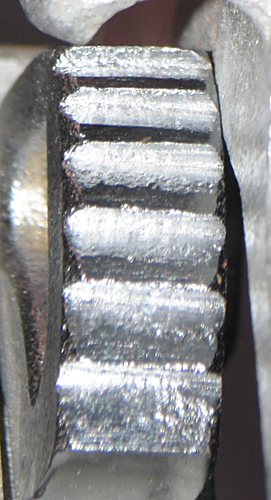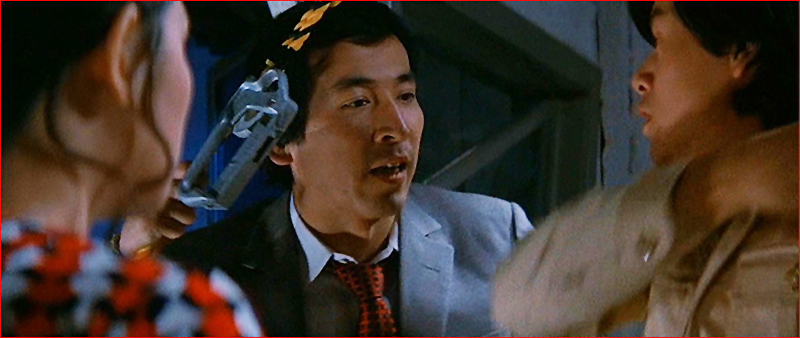Technical Details
I acquired my Tokyo Top from Olivier Peron Caillet in 2015.
 The Tokyo Top is 177 mm. tall, 92 mm. wide, 36 mm. thick, and weighs 375 g.
The Tokyo Top is 177 mm. tall, 92 mm. wide, 36 mm. thick, and weighs 375 g.
The frame is an aluminum alloy casting covered with a
mottled gray paint. The frame has a 14 mm. wide rope channel cast into one
side. The handle is roughly rectangular. A 16.0 by 14.3 mm.
hole in the base of the handle provides access for
the sling ropes. A triangular hole above the cam provides an upper
attachment point for auxiliary slings.
The cam is an aluminum casting. The cam
and cam spring are attached by a 3 mm. rivet. A steel
washer keeps the rivet from pulling into the aluminum frame.
The cam radius increases from 47 to 63 mm. over an angle of 34°, giving a 26° cam angle. The tooth pattern is (Z)^7. The cam is spring-loaded with the spring acting to open the cam. The frame-mounted safety is spring-loaded to open away from the frame. This causes the end of the safety to push against the cam. The safety spring is strong enough to override the cam spring, generating a net closing torque on the cam. Squeezing the cam safety allows the cam to automatically open. A knurled screw on the spine limits how far the safety can close, thereby limiting how far the cam can open. This screw must be retracted to allow the cam to open far enough to rig or derig the ascender.
The only markings on the ascender are a small sticker with a logo and "Tokyo Top Co."
Perhaps because my work requires so much thought, I like Japanese monster movies - they provide entertainment without my having to think. One day in the 1980s, I was watching the classic movie "Godzilla versus Gigan" (Godzilla versus Gigan, Toho Co., Ltd., © 1972). One frame in the movie
shows a Jumar look-alike being used by the good guys in a successful escape from the Godzilla tower where they were being held captive
by the cockroach space aliens:

When this frame passed on the screen, I almost jumped out of my seat! Their escape technique is shear
nonsense, but I was immediately intrigued by the ascender. It appeared to be very similar to a Jumar, but the casting differed
in several respects. For many years I wondered if it really existed, but in March 2008, Carlo Bellestrero sent me a page from an early
1970s Snell Sport Chamonix catalog that showed that this is a
Japanese copy of the Jumar. It was a perfect match to the one shown in the movie. According to the catalog, the ascender weighed
310 g. (versus 250 g. for the Jumar). In February 2015, Olivier Peron Caillet found a pair on a French auction web site,
acquired them, and sent them to me. Along with the Peck Descender and a few others,
these are now among the most valuable items in my collection, not in any monetary sense, but from a personal satisfaction perspective.
But what do I think of these as ascenders? The casting quality is fair at best. The frames do not look too bad, perhaps because they are painted, but the cams are pitted, showing that gasses did not fully escape during the casting process.
Z-teeth do not work well on eccentric cam ascenders, and these are prone to slip.
Rigging the ascender is a nuisance, since one must unscrew the knurled screw to allow the cam to open far enough to admit the rope - and then one must repeat the process for derigging.
Squeezing the safety lever opens the cam, seemingly convenient, but I find that my hands get in the way of the cam (I have large hands). The mechanism is different than I've seen on any other ascender; alas, I cannot say that it is better.
Finally, these are heavier than the Jumars of the same era (the catalog weight of 310 g. was low by 20%). Back in those days, the Japanese were famous for their low quality products (no longer true!), and these ascenders met the low expectations of those days.


